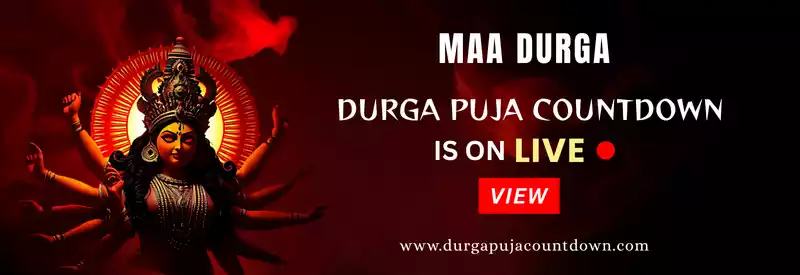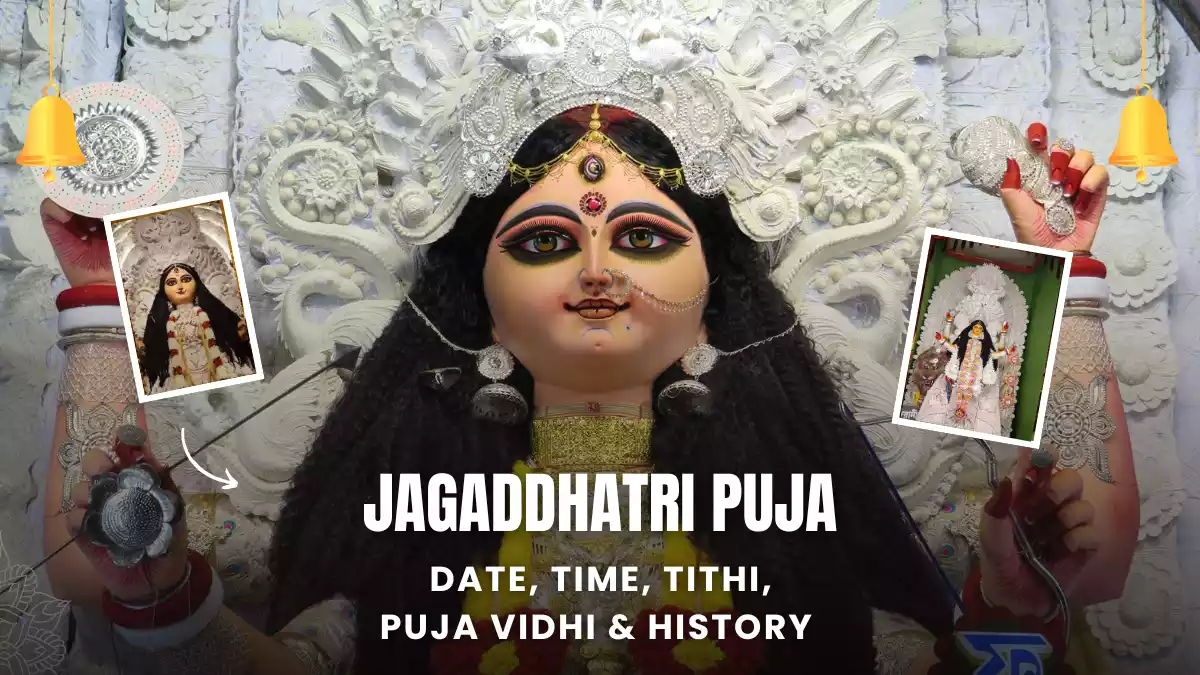Jagaddhatri Puja 2025 is a beautiful occasion to honour the divine Mother in her form as Protector and Sustainer of the World. The date falling on 31 October 2025 (Navami of Kartik month).
Jagaddhatri Puja is very special at Chandannagar, West Bengal and also at Krishnanagar. Chandannagar is famous for its fabulous lighting decoration. During this period, the entire city is decorated with many colourful modern lights especially at the time of Bishorjon.
Its devotees have an opportunity to engage in ritual and reflection that merges spiritual aspiration with cultural celebration.
 Join Now
Join Now
What is Jagaddhatri Puja?
The word “Jagaddhatri” comes from two Sanskrit parts: “jagat” meaning world, and “dhatri” meaning sustainer or protector. So the name literally means “Protector/Sustainer of the World”.
In Hindu tradition, Jagaddhatri is regarded as a form of Goddess Durga – the Divine Mother and is worshipped with great devotion especially in the state of West Bengal (India) and among Bengali communities.
This festival emphasises the mother-goddess’s role in nurturing, protecting and sustaining the universe, as well as the triumph of virtue over evil.
Jagaddhatri Puja in 2025 Date, Time & Tithi
The puja is celebrated on the Navami (9th day) of the Shukla Paksha in the lunar month of Kartik.
Jagaddhatri Puja in 2025 Date: Friday, 31st October 2025 (Navami)
Navami Tithi Begins – 10:06 AM on 30th October, Thursday, 2025
Navami Tithi Ends – 10:03 AM on 31st October, Friday 2025
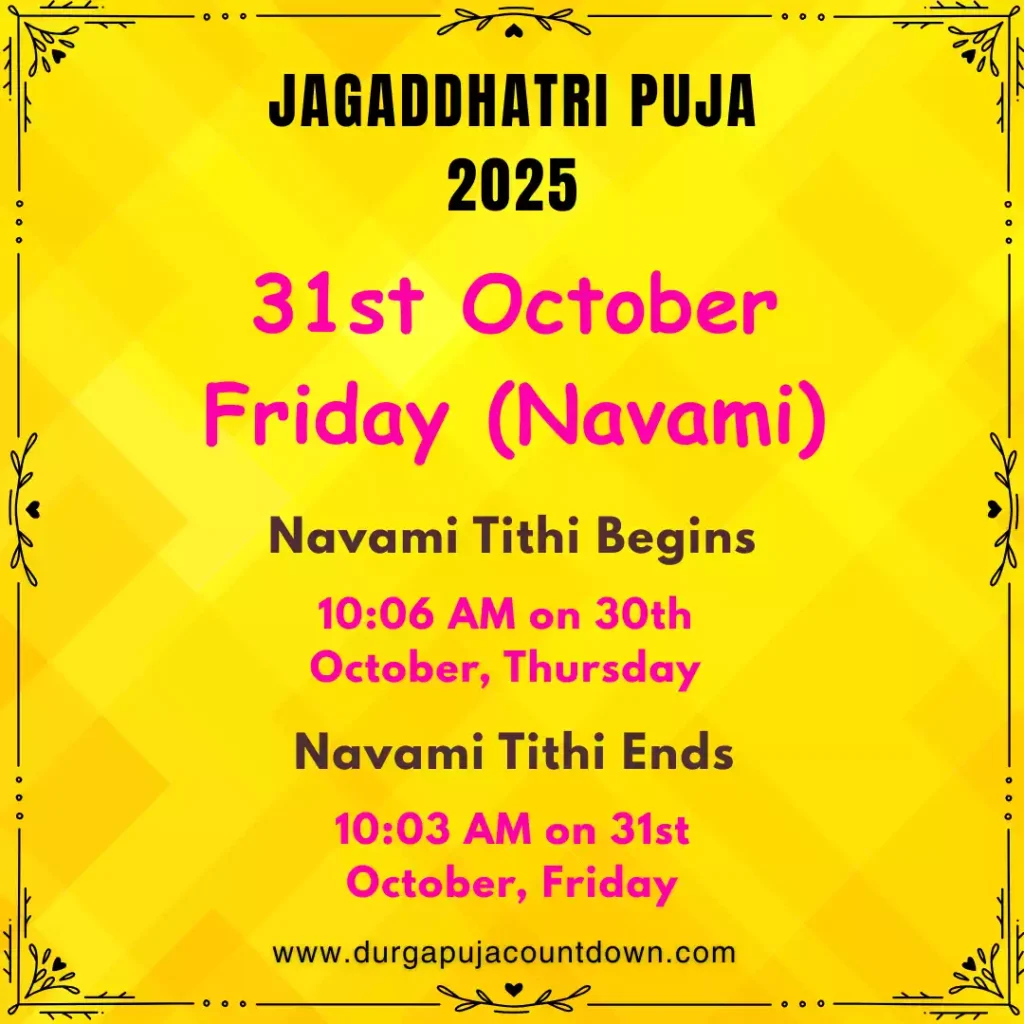
Here’s a clean and well-structured table based on the daywise Jagaddhatri Puja 2025 festival schedule
| Day / Event | Date (2025) | Day of the Week |
|---|---|---|
| Maha Panchami | 27th October 2025 | Monday |
| Maha Shasthi | 28th October 2025 | Tuesday |
| Maha Saptami | 29th October 2025 | Wednesday |
| Maha Ashtami | 30th October 2025 | Thursday |
| Maha Navami | 31st October 2025 | Friday |
| Bijaya Dashami | 1st November 2025 | Saturday |
History of Jagaddhatri Puja
There are a few legends associated with Jagaddhatri Puja, key ones being:
1. A widely cited legend says that Raja Krishnachandra of Krishnanagar in Nadia district was imprisoned and while returning felt deprived of the festive Durga Puja celebrations.
In his dream, the goddess appeared to him and asked that she be worshipped on the ninth day of Kartik’s Shukla Paksha. That goddess was later realised as Jagaddhatri.
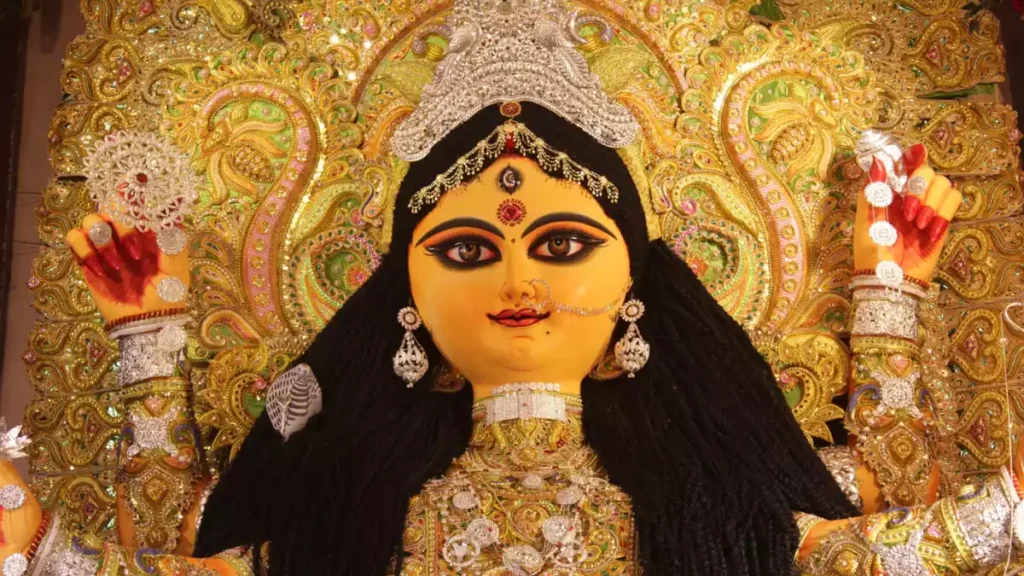
2. Another story holds that after the defeat of the demon Mahishasura, the gods became arrogant. The demon disguised himself as an elephant-form called Karindrasura.
To defeat this arrogant power, the goddess in the form of Jagaddhatri (riding a lion) destroyed the elephant demon, signifying the victory of wisdom and divine power over ego and illusion.
These legends emphasize that the festival is not merely ritualistic but has deep symbolic meaning: humility, divine protection, triumph of good.
Puja Vidhi of Jagaddhatri Puja
Here is a simplified outline of how the puja is generally observed:
Early Morning: Wake up early, take a bath and wear clean clothes.
Fasting or Observance: Many devotees observe a fast or maintain certain purity and devotion during the day.
Setup & Cleaning: The idol or image of the goddess is cleaned, red clothes are offered/used, the puja-area is prepared.
Offerings:
- Flowers (especially red or crimson), vermilion (sindoor), durva (grass), sandalwood, sweets, fruits, water.
- Incense (dhoop), lamps (aarti) are offered.
Chanting & Mantras: Devotees recite the Jagaddhatri Mantra and Jagaddhatri Stotram.
Bhog or Prasad: After the main ritual one breaks the fast and distributes prasad (offering given back to devotees).
Conclusion: Much like other goddess-pujas in Bengal, the idol may be immersed (visarjan) after the ritual-day, depending on local custom.
Jagaddhatri Puja Significance
This festival holds multiple layers of significance, spiritual, cultural, and social. Key points:
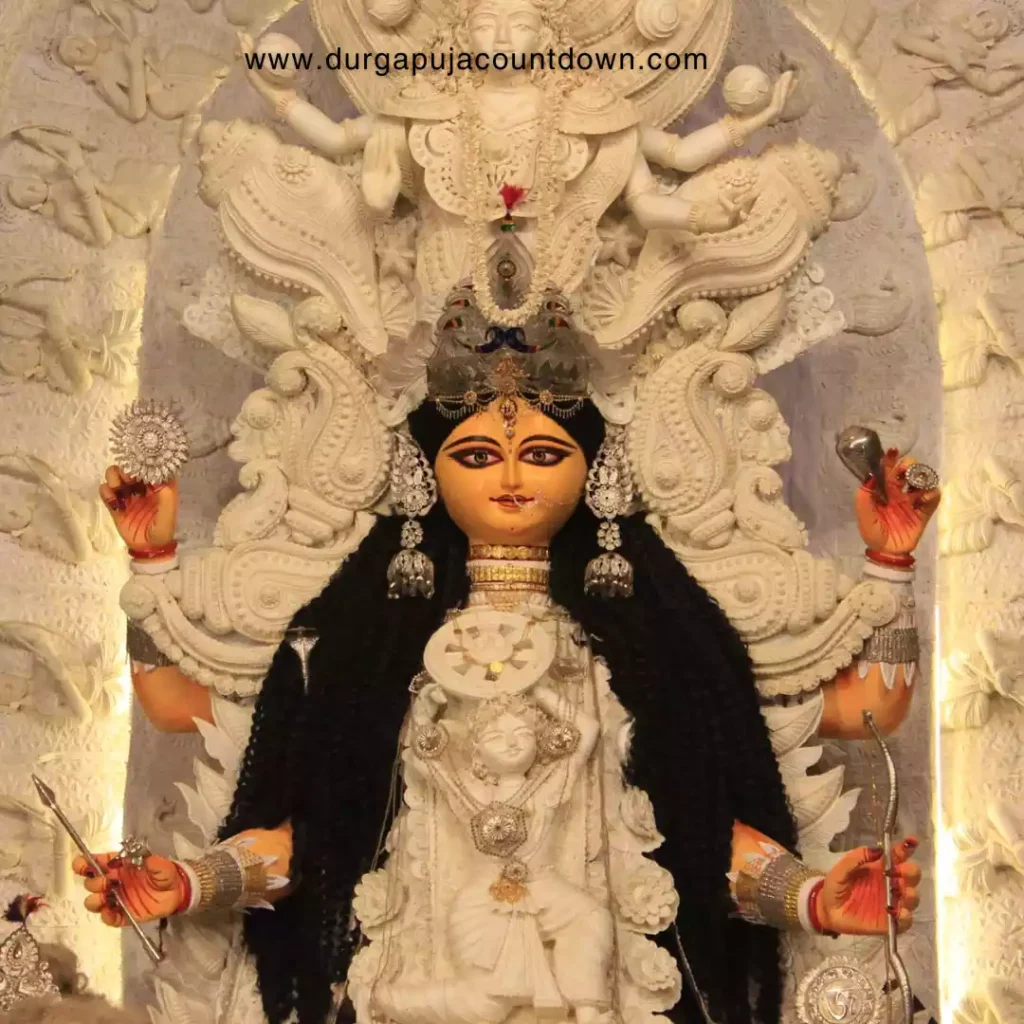
- Worship of Jagaddhatri is believed to bring protection, prosperity, and peace into the devotee’s life.
- It fosters inner strength, fearlessness, and release from ego, jealousy and other negative emotions.
- At a cultural/community level, the festival creates strong sense of togetherness, artistic expression (pandals, idols), and preserves heritage, especially in Bengal.
- The symbolic meaning of the goddess: riding a lion, holding a conch, bow, arrow, discus — all symbolize control over mind, intellect, action and the removal of ignorance/evil.
Jagaddhatri Puja is not just about external ritual, but is meant to inspire internal transformation to align oneself with divine wisdom, humility and the sustaining power of the universe.
Why Celebrate Jagaddhatri Puja?
- Connect with tradition and heritage, especially important for Bengali communities and anyone wishing to do so.
- Use the timing (Kartik Shukla Navami) as an auspicious moment to start something new, seek blessings for the coming year.
- Reflect on the deeper spiritual message: overcoming ego, protecting what is good, sustaining harmony in one’s life and community.
- Participate in the vibrant aspects of the festival: beautifully decorated pandals, idols, community programmes, even if celebrating at home one can bring in simple rituals.
Pro Tips for Home Celebration
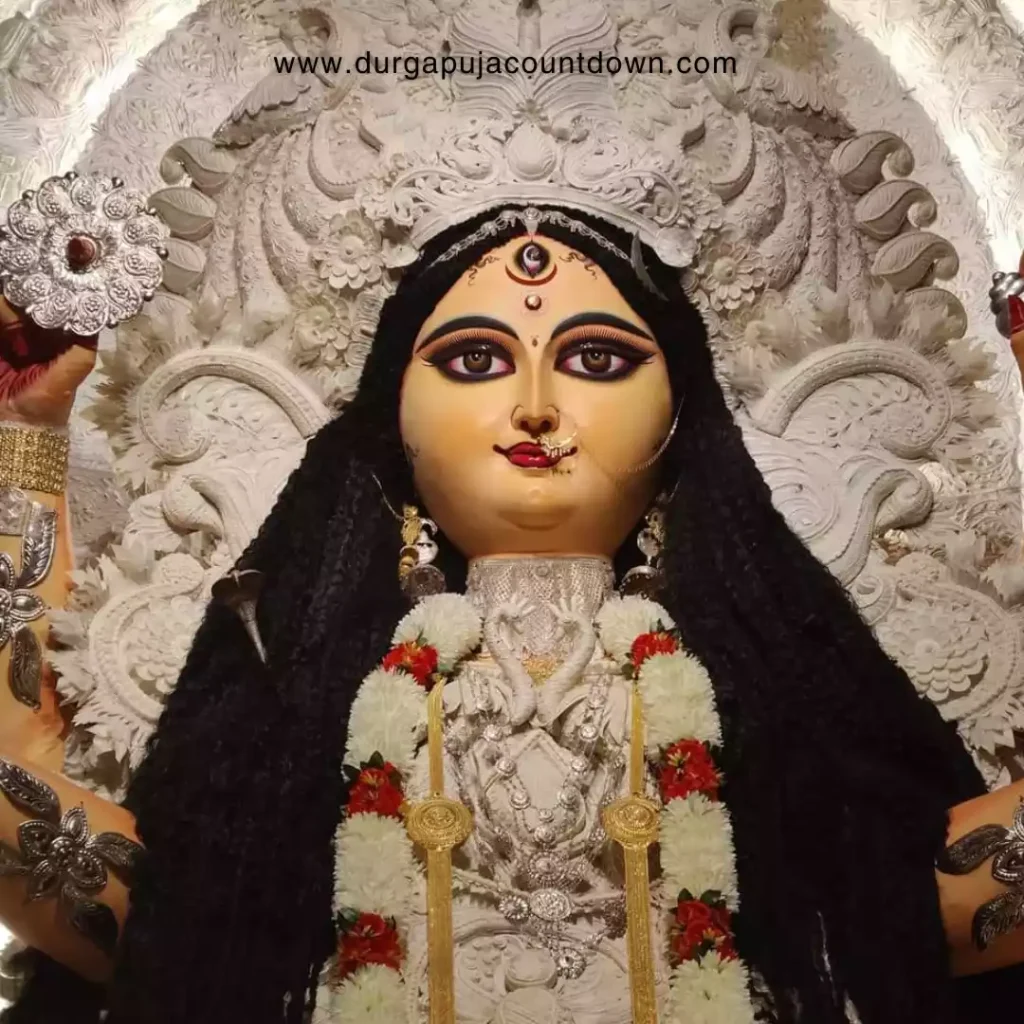
1. Decide on the muhurta/time for your region (consult local almanac).
2. Clean the puja space, set up an idol or picture of Goddess Jagaddhatri.
3. Dress the goddess (or image) in red clothes or cloth and offer a garland if possible.
4. Offer red/crimson flowers, vermilion, durva grass, sandalwood and water.
5. Prepare simple prasad: fruits, sweets, a light meal after rituals.
6. Chant the mantra, spend a few minutes in silent prayer, and reflection on what you’re seeking (protection, strength, wisdom).
7. Conclude with aarti and distribution of prasad.
8. Optional: Visit a local Jagaddhatri Puja pandal, participate in the local community festival if available.
Whether one observes it in a grand pandal or quietly at home, the essence remains: seeking divine protection, nurturing inner strength, and celebrating the victory of good over ego and ignorance.
Durga Puja Countdown is on Live for next year
